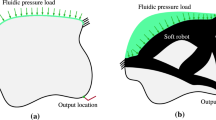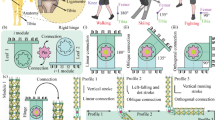Abstract
In this work, a planar three degree-of-freedom parallel mechanism as another type of assembly device which utilizes joint compliances is proposed. In order to generate the desired operational compliance characteristics at RCC point, these joint compliances can be adjusted either by properly replacing the joint compliances or by actively controlling stiffness at joints. The operational compliance matrix for this mechanism is obtained explicitly by symbolic manipulation, and its operational compliance characteristics are examined. It is found that the RCC point exists at the center of the workspace when the mechanism maintains symmetric configurations. Compliance characteristics and its sensitivity of this mechanism are analyzed with respect to the magnitude of the diagonal compliance components and two different matrix norms by measuring compliance sensitivity. It is expected that the analysis results provide the designer with a helpful information to determine a set of optimal parameters of this RCC mechanism.
Similar content being viewed by others
References
Brussel, H. V. Thielemans, H. and Simons, J., 1986, “Further Developments of The Active Adaptive Compliant Wrist (AACW) For Robot Assembly,”Proc. th Int'l Symp. on Industrial Robots, SME, pp. 377–384.
Cutkosky, M. R. and Wright, P. K., 1986, “Active Control of a Compliant Wrist in Manufacturing Tasks,”Transactions of the ASME, Vol. 108, pp. 36–43.
Cutkosky, M. R. and Kao, Imin, 1989, “Computing and Controlling the Compliance of a Robotic Hand,”IEEE transaction of robotics and automation, Vol. 5, No. 2, pp. 151–165.
De Fazio, T. L., Seltzer, D. S. and Whitney, D. E., 1984, “The Instrumented Remote Center Compliance,”The Industrial Robot, Vol. 11, No. 4, pp. 238–242.
Freeman R. A. and Tesar, D., 1988, “Dynamic Modeling of Serial and Parallel Mechanisms/ Robotic Systems, Part 1-Methodology, Part II-Applications,”Proceedings of 20th ASME Mechanisms Conference, Orlando, FL. pp. 7–21.
Hogan, N., 1985, “Impedance Control: An Approach to Manipulation: Part I, II, III,”ASME Journal of Dynamic Systems, Measurements and Control, Vol. 107, pp. 1–24.
Kazerooni, H., et al., 1986, “Robust Compliant Motion for Manipulators, Part I: The Fundamental concept of Compliant Motion, Part II: Design Method,”IEEE Journal of Robotics and Automation, Vol. RA-2, No. 2, pp. 83–92, 93–105.
McCallion, H., Alexander, K. V. and Pham, D. T., 1980, “Aid for Automatic Assembly,”Ist Int' l. Conf. on Assembly Automation, pp. 313–323.
Peshkin, M. A., 1990, “Programmed Compliance for Error Corrective Assembly,”IEEE Transactions on robotics and automation, Vol. 6, No. 4, pp. 474–482.
Whitney, D. E., 1982, “Quasi-Static Assembly of Compliantly Supported Rigid Parts,”Journal of Dynamic Systems, Measurement, and Control, Vol. 104, pp. 65–77.
Whitney, D. E., “Remote Center Compliance,” 1986, inEncyclopedia of Robotics System and Control, edited by J.J. Diponio and Y. Hasegawa, published by Industrial Training Corporation, Vol. 2, pp. 1316–1324.
Whitney, D. E., 1987, “Historical Perspective and State of the Art in Robot Force Control,” Int' J. Journal of Robotics Research, Vol. 6, No. 1 pp. 3–14.
Yi, B. J. and Freeman, R. A., 1992, “Synthesis of Actively Adjustable Springs by Antagonistic Redundant Actuation,”Trans. ASME J. of Dynamic Systems. Measurement, and Control, Vol. 114, Sep., pp. 454–461.
Author information
Authors and Affiliations
Rights and permissions
About this article
Cite this article
Kim, W.K., Kim, D.G. & Yi, BJ. Analysis of a planar 3 degree-of-freedom adjustable compliance mechanism. KSME Journal 10, 286–295 (1996). https://doi.org/10.1007/BF02942637
Received:
Issue Date:
DOI: https://doi.org/10.1007/BF02942637




